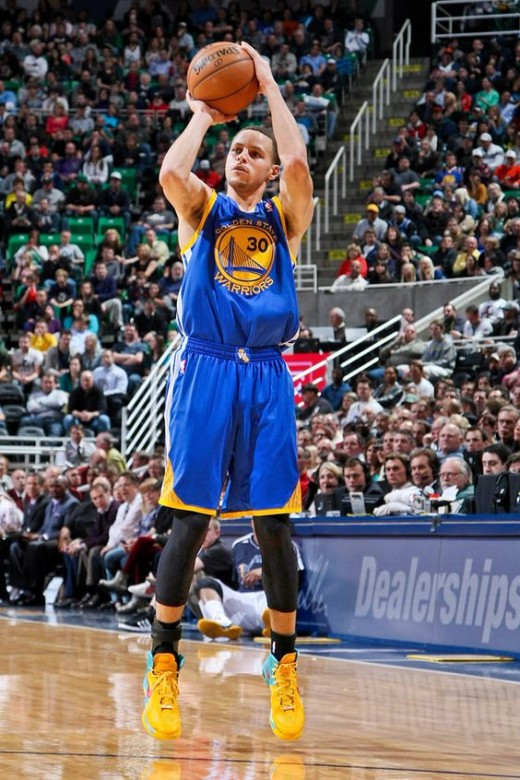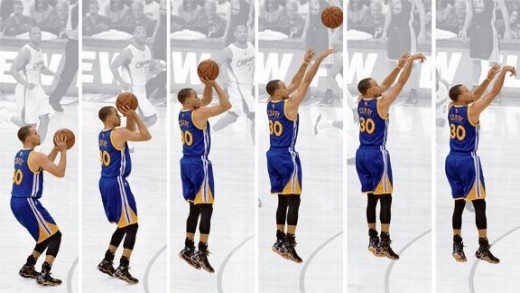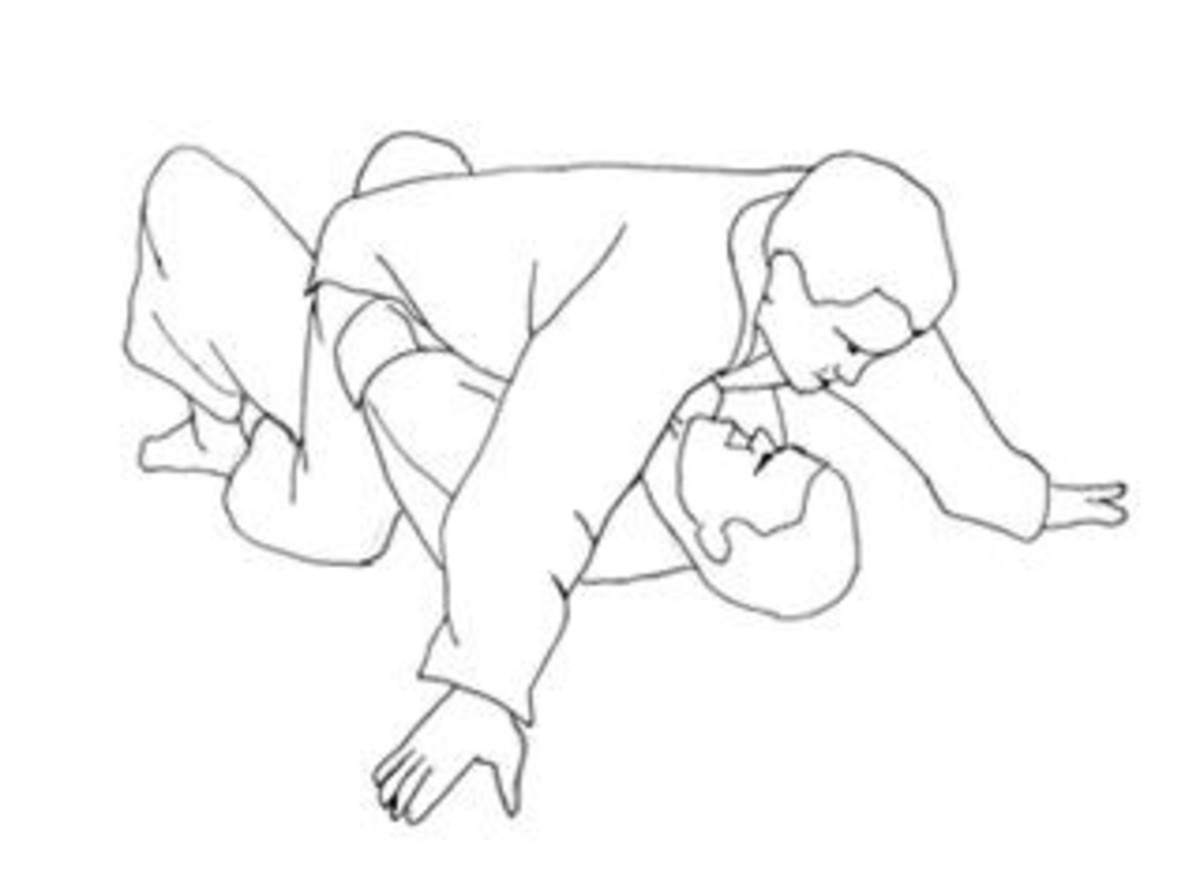The Science Behind Shooting a Basketball



The Science Behind Shooting a Basketball
Many good players make it look so easy. A lot of people watch basketball and don't even realize that shooting is a form of art. There is a lot more behind shooting basketball than you would think. The science behind it is pretty cool and if you look at it closely it all makes sense. Some of the science has to do with angles, arc, speed of the shot, Newton's third law, release point, and the ball's trajectory. One example is as you get closer to the hoop, the speed of the ball should decrease and the angle that you shoot it at should be higher. Another example is if you have good arc on your shot there is a better chance the ball will go in. This is scientifically proven because with an arc on your shot the ball just has a better and easier path to land in the net. If you shoot the ball in the air at a straight line towards the hoop, it would rarely go in because it’s a bad angle. Those are just a few examples of how there is science behind shooting a basketball.
To shoot a basketball pretty well you have to be very coordinated and practice over and over again. Looking at the science behind shooting can help you become better because when you break it down it all has to do with the right mechanics. One thing that is very important when shooting a basketball is the backspin on the ball. When you are shooting, the ball should roll off your finger tips and rotate in the air about 2-3 times per second. The reason why this is so important is if you hit the rim and the ball has spin on it, it will most likely roll into the net. If you have no rotation on your shot and the ball hits the rim, most of the time it will just bounce right off. Shooting softer and having a gentle touch can also increase the chances of the ball going in the hoop. When the ball hits the rim gently, it will most likely find it’s way into the net. When you shoot a basketball harder there is a stronger force on it. Once it hits any part of the hoop, it will usually bounce right back towards you or away from the hoop because the force is too strong. This shows why you want a softer touch and good rotation on your shot.
Another thing that has to do with the science behind shooting a basketball is Newton’s third law. It states that “For every action there is an equal and opposite reaction.” You can see this law when somebody is shooting because they are applying a force to the ground. When you shoot a jump shot you bend your knees. All of your weight is then transferred to your legs and pushed towards the ground. This is the action that is taking place. The equal and opposite reaction is when you use your legs to push back up and jump into the air. The more force that you apply to the ground, the higher you will be able to jump. If you don't bend your knees that much you won't get as much lift on your jump shot. You want to be able to shoot over your defender so it's important that you jump high enough to get your shot off. Only some very tall players can get their shot off without bending their knees because nobody is able to block it. That is why it's important to bend your knees when shooting.
Angles and speed of the shot are also another important part of science that has to do with shooting a basketball. Different distances from the hoop require different angles and different speeds in order for the ball to go in the hoop. An example of this is that a 3 pointer should be shot at about 18 mph and released at about 45 degrees. A free throw should be shot at about 14 mph and released at an approximate 50 degree angle towards the hoop. Distance is one thing that affects angles of release but another thing that affects this is how tall you are. For example a 6 footer should shoot a free-throw at about 51 degrees and a 7 footer should shoot one at about 49 degrees. Smaller players tend to be better at free-throws than bigger players and part of this could be because taller players might have to shoot at tougher angles. There are so many things that can affect shooting, but when you look at all the science, angles and speed of the shot probably affect it the most.
The arc on your shot is also another thing that can increase the chances of the ball landing in the hoop. If you think about this it makes perfect sense. The ball is above the rim for a longer time and has a better trajectory when shot on an arc. When it is shot at a very low arc or no arc at all, it’s above the rim for a shorter amount of time. Also the trajectory is not good at all when shot at a low arc because the angle for the ball to go through the rim is very narrow. That is why all good shooters and NBA players have higher arcs. One player in the NBA who has a really high arc is Stephen Curry. This year he just set an all time record of 402 threes in a single NBA season. Because of his higher arc he’s able to hit more threes and increase the chances of his shots going in. That’s why it’s definitely better to have a higher arc when shooting a basketball.
The last thing that can really affect your shot is the release point. It's very important to know when to release the ball when shooting. The proper time to release the ball is on the way up, just before you reach the top of your jump. If you shoot too late when you’re coming back down, the shot will be short and probably hit the front rim. If you release the ball too early you might not be able to get it off because defenders can block it. This is why you want to release the ball just before you reach the top of your jump. This will help you to not get blocked and it will just be better timing and allow you to have a more accurate shot. As you are going up in the air, all of your momentum is going up too and can help you shoot farther. If you shoot the ball when you're coming down, all your momentum is also coming back down and you won't be able to shoot as far. That is how release point affects the timing and accuracy of your shot.
Shooting a basketball takes a lot of practice and might not be for everyone, but the science behind it is pretty interesting. So many people would never think that there is so much science behind something like this. If more people knew about all the science behind shooting a basketball they would probably be really fascinated and think it’s pretty cool. When most people watch a basketball game they don’t realize that shooting is truly a form of art and has to be practiced over and over again. They don’t see all the science behind it like the angles of release, arc, trajectory, and the speed of the ball. In order for a basketball to go in most of the time, all of this has to be right. That's why it has to be practiced a lot until a shooter’s mechanics are perfect. Now you pretty much know all the science behind shooting a basketball.
Sources:
Tarkanian, J. “Basketball Shooting-The Art and Science of Shooting a Basketball.” 2013.
www.coachlikeapro.com. 12 May. 2016 www.coachlikeapro.com/basketball-shooting.html
“The Physics of Shooting.” 2016. Fisher Sharp Shooters. 12 May. 2016
www.secretsofshooting.com/the-physics-of-shooting/
“The science behind shooting a basketball.” 13 Sept. 2015 Zhijun Sun. 12 May 2016
https:/sites.psu.edu/siowfa15/2015/09/13/the-science-behind-shooting-a-basketball/



